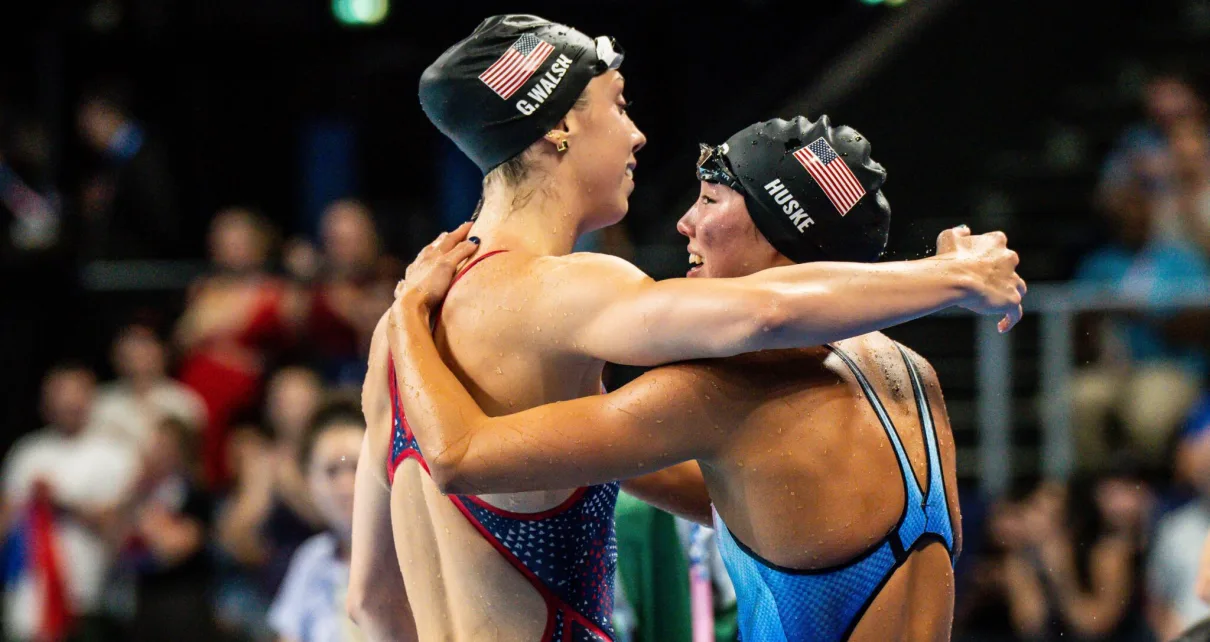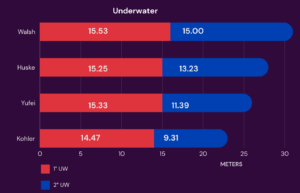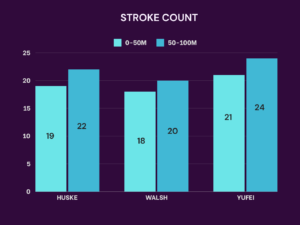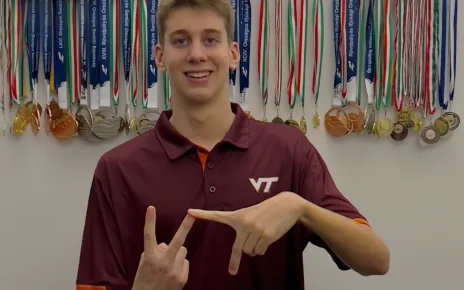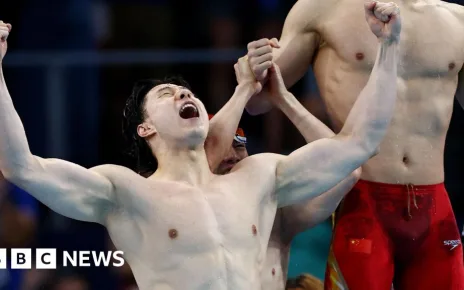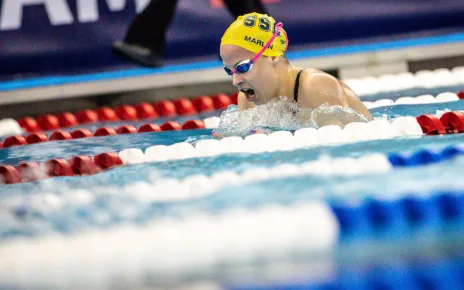UNBELIEVABLE DISCOUNTS AT AMAZON.COM ||
The French Swimming Federation has released detailed statistics on all the swimming finals at the Paris Olympics, and in this article, we will analyze the women’s 100-meter fly final.
The women’s 100 fly was one of the most anticipated events at the Paris Olympics. A few weeks earlier, at the US Trials, Gretchen Walsh set a new world record for this distance with a time of 55.18. The second swimmer to qualify at the trials was Torri Huske, who held a personal best of 55.64 (2022) at that point.
We do know how this race ended up: Gretchen Walsh, whose best time was almost half a second faster than the best fly swimmers in history, lost the Olympic title.
From the graph below, we can already identify key points to analyze in order to understand the errors and effective strategies used in this race. For instance, it shows:
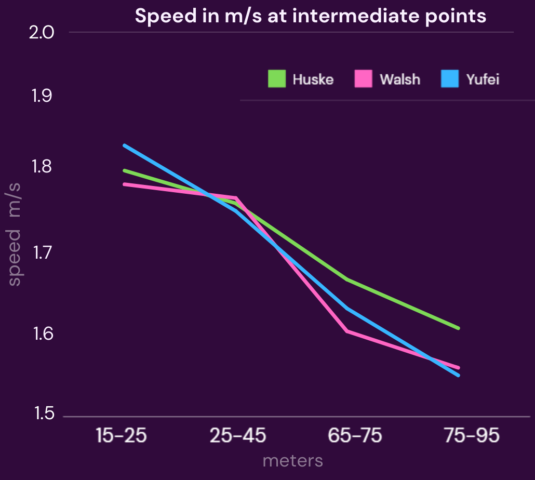

Let’s break it down meter by meter
We will analyze the race by dividing it into two parts. In the first part, we look at “non-swimming” actions, such as the start and underwater phases. In the second, we focus on the swimming phases, the turn, and the finish.
NON-SWIMMING PHASES
Start
-
- Looking closely, Gretchen Walsh‘s start, slower by about 0.1s compared to her rivals, could be one of the factors that contributed to her second place.
- Despite this, her dive and underwater phase allowed her to reach the highest speed among the three, peaking at 3 m/s.
Underwater Phases
- This chart clearly shows how important the underwater phase is for U.S. swimmers.
- Gretchen Walsh swam more than 30% of her race underwater, compared to 28% for Torri Huske and 26% for Zhang Yufei.
- Walsh was also the only one to reach 15m underwater after the turn.
However, the distance covered underwater is not the only factor favoring the Americans. The speed gained with it is crucial. In Walsh’s case, it is interesting to note that her second speed peak, unlike her rivals, occurred at the exit of the second turn (1.85 m/s), not during the swim.
SWIMMING PHASES
25-Meter Standings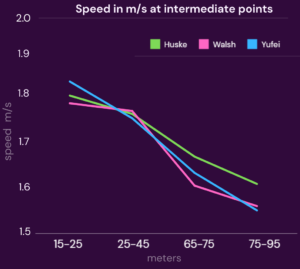

- Zhang Yufei 11.35
- Gretchen Walsh +0.09
- Torri Huske +0.16
45-Meter Standings
- Gretchen Walsh 22.64
- Zhang Yufei +0.04
- Torri Huske +0.10
-
- As seen in the 25-meter standings and the average speed in the first lap, the fastest in the first part of the swim was Zhang Yufei.
- However, thanks to the speed gained from the underwater phase and the dive push, Gretchen Walsh, immediately catches up with her rivals, and despite a slightly slower swimming speed, reaches the 45m with a 0.04s advantage.
Turn and Push-off from the Wall
65-Meter Standings (Upon exiting the second underwater phase)
- Gretchen Walsh 33.50
- Zhang Yufei +0.57
- Torri Huske +0.69
The best combination of approach, turn, and push-off efficiency was by Gretchen Walsh, who gained more than half a second over her rivals in these technical 20 meters.
75-Meter Standings
- Gretchen Walsh 39.72
- Torri Huske +0.44
- Zhang Yufei +0.46
At 75 meters, the win is less certain for the 2002 swimmer, as her fellow Torri Huske has nearly halved the gap. Despite this, Walsh still leads the race with a 0.44s advantage. A lot for a swimmer. Or maybe not.
Final Phase
95-Meter Standings
- Gretchen Walsh 52.55
- Torri Huske +0.02
- Zhang Yufei +0.54
As expected, and as confirmed by the graph, Torri Huske managed to conserve more energy than her teammate. While Huske, in the first part of the second lap, began gaining tenths upon tenths, Walsh continued to lose speed. A true fall if you look at the pink line between 50m and 75m in the pic.
The green line, representing Torri Huske, is the most consistent of the three, allowing her to get within a few hundredths of Gretchen Walsh just 5 meters from the finish.
Nonetheless, a more rapid final stretch for Gretchen Walsh, along with a slightly longer glide in the last two meters by Torri Huske, ultimately proved decisive.
The swimmer, already propelled by the highest speed—over 1.6 m/s in the last part of the race—gave nothing away in the final meters, and with an excellent finish, she gained crucial hundredths over her opponent. Walsh’s finish wasn’t terrible; the last 5 meters were swum in 3.08 seconds by her and 3.02 seconds by Huske. However, due to the disadvantage accumulated in the return lap, those 0.06s allowed her teammate to touch the wall first.
PODIUM
- Torri Huske 55.59
- Gretchen Walsh 55.63
- Zhang Yufei 56.21
Bonus: Stroke Count
Gretchen Walsh with 38 strokes was the swimmer who took the fewest strokes in the entire 100. This was predictable based on observations of the significant distance swum underwater by the American. However, it’s not the only significant factor. Although Walsh was slower than her fellow Huske in swimming speed, with a lower stroke rate, she was the athlete who registered the greatest distance covered per stroke cycle. In the segment between 25 and 50 meters, Walsh advanced about 1.94m per stroke cycle, with a total average of 1.83m per stroke over the 100, compared to Torri Huske‘s 1.79m per stroke and Zhang Yufei‘s 1.65m per stroke.

